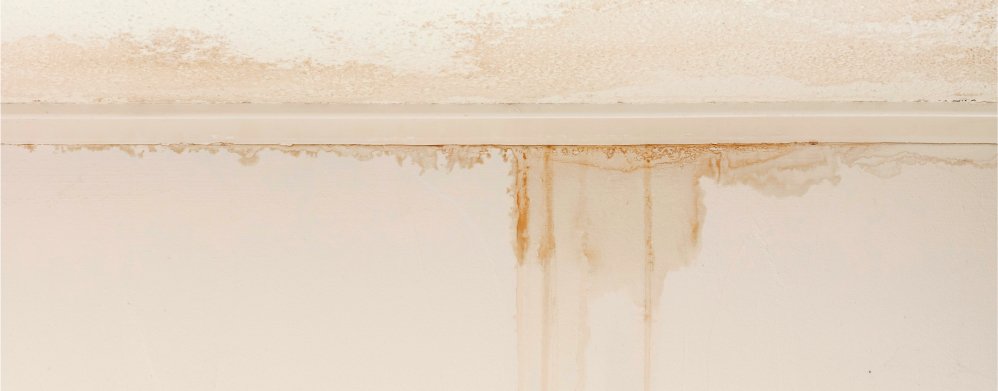
Water ingress is an unfortunate feature of property ownership and maintenance. When owning and/or living in an Owners Corporation, the lines can often be blurred and complicated regarding the cause of water ingress, the responsibility for repair and the liability for damage.
At first instance, please always contact your Owners Corporation Manager and notify them of any water ingress.
Common instances of ingress are;
- Acute events such as burst pipes or leaking appliances;
- From the balcony of one apartment into the apartment below;
- From gutters into an apartment;
- From downpipes and drains into an apartment;
- Failed waterproofing and/or caulking of a wall/roof;
- Failed/worn sealant around a window or joint.
Acute Events.
Often, the cause of water ingress and leaks is an acute event such as a burst pipe, overflowing sink or leaking appliance such as washing machine or dishwasher, or even a burst private hot water unit.
In Victoria, under s16(1) of the Water Act 1989, liability follows the cause;
16 Liability arising out of flow of water etc.
(1) If—
(a) there is a flow of water from the land of a person onto any other land; and
(b) that flow is not reasonable; and
(c) the water causes—
(i) injury to any other person; or
(ii) damage to the property (whether real or personal) of any other person; or
(iii) any other person to suffer economic loss
— the person who caused the flow is liable to pay damages to that other person in respect of that injury, damage or loss.
In instances of an appliance failure, there is a clear cut liability of the owner of the failed equipment. They will be responsible for damage to your lot and private possessions. Likewise, you will be responsible if you leave the tap running and it overflows into other apartments, or your hot water service bursts or air-conditioner run-off piping leaks and the water causes damage to other apartments.
In instances of a burst (or leaking) pipe, the liability will follow the particular pipe in question. If a pipe services one lot, then that lot which it services is responsible for its maintenance, per s129(b) of the Owners Corporation Act 2006;
129 Care of lots
A lot owner must—
- properly maintain in a state of good and serviceable repair any part of the lot that affects the outward appearance of the lot or the use or enjoyment of other lots or the common property; and
- maintain any service that serves that lot exclusively.
By way of example, this means that if a pipe feeding your shower head bursts behind the wall, you as lot owner will be responsible for the repair costs and damage caused. If the pipe serves multiple lots, i.e. is ‘further back’, and serves multiple lots, then the pipe is deemed common and is the responsibility of the Owners Corporation, as is the liability for damage.
Water on common property.
A recent change to the Owners Corporations act makes it more likely that the Owners Corporation will need to get involved, in some instances.
17 Water on common property
- Any rainwater or other water that falls, occurs or flows on the common property (otherwise than in a waterway or a bore) is taken to be part of the common property.
What is important here is the type of boundaries depicted on your plan of subdivision. For example, if you have internal boundaries – meaning the plaster, ceiling and floor are part of your lot, but the slab, roof and walls are not – then the water, even if only travelling between two lots, is considered to be common property, and therefore draws the Owners Corporation into the discussion.
Again, it is the recommendation of The Knight to alert your Owners Corporation Manager about any instance of water ingress into your lot, so the appropriate follow up steps can be taken.
Investigations.
In the event that the water ingress is travelling from one property to another – whether private lot to private lot, or from common property to private property – and is NOT due to an acute event such as burst or leaking pipe, or appliance failure, a more in depth investigation is usually required.
The burden for investigation falls to the party claiming damage. It is important to be aware that you may be required to cover initial (and possibly permanent, non-recoverable) costs in this respect. The Owners Corporation is not in a position to arrange these costs and then seek to recover at a later date.
Many parties will give an undertaking of paying ‘reasonable’ costs and then withdraw that undertaking once the invoice is received. The Owners Corporation is not responsible for taking on that burden initially, nor ongoing, and it is not the role, nor within the jurisdiction or authority of either the Owners Corporation or the Owners Corporation Manager to become involved in matters between two or more private lot owners.
Balconies.
Per the Plan of Subdivision Act, and its Regulations, and as per confirmed of the Fisher case, a lot owner is responsible for the tiles, grout, waterproofing, screed and membrane of their balcony tiles, unless explicitly stated otherwise on an individual Plan of Subdivision (which is extremely rare) in Victoria.
Depending on the boundary type that exists on your Plan of Subdivision, the lot owner may also share full ownership of the slab/s that sit above and beneath (i.e. between apartments), meaning there is no common property between the apartments.
In the instance of a suspected leak from a balcony that is affecting your apartment, you should notify your Owners Corporation Manager with The Knight, who will attempt to contact the relevant lot owner above you. You will then need to work with the suspected responsible lot owner and potentially engage in a leak detection contractor to confirm the source of the leak (being the balcony).
If indeed the balcony is responsible, that lot owner will need to refurbish their balcony, which is usually a costly exercise. This is turn may lead to reluctance or refusal to undertake the necessary repairs. Whilst the Owners Corporation has the ability to serve a Notice of Repairs on that lot owner, should the Owners Corporation Committee resolve to do so, the Owners Corporation is not well positioned to pursue legal action on the matter, and the Committee may not be inclined to pursue that step on behalf of one lot owner.
It is the recommendation of The Knight that any legal action be individually pursued by the affected party(ies), on the basis of those parties being able to initiate legal action more efficiently (we would expect an additional delay of 3-6 months delay as a minimum before the Owners Corporation could take legal action, compared to the affected lot owner), and that the costs and liability would be borne by the appropriate party.
The role of the Manager in this instance is to bring the two parties into contact with each other and provide advice about potential next steps, and possible referral of contractor references. If the Owners Corporation Committee elects to pursue the matter on behalf of the Owners Corporation, additional costs may be applied for any management of the item by your Manager.
Leaking gutters, downpipes & drains.
Please notify your Manager of any suspected leaking from this infrastructure that is causing water ingress into your apartment, and provide photos of both the damage and source. Your Manager will review both the location, and the function of the service in question. Taking into account the location, how many lots are served, and the boundary type and notes prescribed on the Plan of Subdivision for your property, your Manager will inform you whether it is private or common property and therefore whose responsibility to rectify.
Failed waterproofing, caulking, sealant or structure.
Similarly to failed service infrastructure, please provide photos and a location to the Manager of where you believe ingress is occurring from. Taking into account the location, the boundary type and notes prescribed on the Plan of Subdivision for your property, your Manager will inform you whether it is private or common property and therefore who has the responsibility to rectify.
Insurance & repair of damage.
A common query raised in the context of a water leak is insurance. Insurance exists to rectify resultant damage, in the event of an insurable event. Insurance does NOT provide assistance for rectifying the cause of damage in the first instance. If your balcony integrity has failed and requires replacement, you will be responsible for the refurbishment costs, unless it was damaged due to a particular insurable event – e.g. bricks falling from above building works etc.
Once the cause of water ingress is rectified, you may wish to make a claim on the Owners Corporation’s building replacement insurance policy. Please contact insurance@theknight.com.au for this action. Please be advised that whilst per s16 of the Water Act (noted earlier), the liable lot owner is responsible for damages, they may not be agreeable to paying the excess and resist this or simply not pay. Accordingly, when making a claim on the Owners Corporation’s policy, The Knight’s position is that the claimant is responsible for the excess for any claim. You may wish to pursue the liable lot owner for this excess if it remains in dispute. If common property is responsible for the source and/or flow of the water, then the Owners Corporation will pay the excess.
Separate to utilising the insurance policy of the Owners Corporation, you may wish to directly pursue the liable lot owner for all costs. This will also be the path you need to follow for financial restitution if the amount you are claiming falls below the Owners Corporation’s policy excess. Many Owners Corporations specifically negotiate for a higher premium excess so as to have a lower premium price (in turn reducing impact to annual levies), and to prevent an abundance of minor claims which tend to increase the policy’s premium over time.
Once again, these actions are between two (or more) private parties, and are not a matter for the Owners Corporation Committee or Owners Corporation Manager. If the Owners Corporation is the liable party for the damage you have incurred, recommendation of The Knight to the Owners Corporation Committee will be either a claim on the policy, or simply paying for the damage directly, taking into account claims history and the quantum sums involved.
Defects.
If you believe your water ingress is due to a building defect of the original construction, you may have recourse against the original builder for either repairs or damages, and possibly costs-to-date as well. The result of the relevant investigation will inform of the cause of the ingress, which can be then be determined as either a maintenance matter, or a defect matter. Your Manager will advise accordingly.

